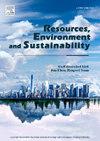Public water risk concerns triggered by energy-transition-mineral mining
IF 12.4
Q1 ENVIRONMENTAL SCIENCES
引用次数: 0
Abstract
The intensifying demand for energy transition minerals (ETMs) has triggered global concern over water-related issues in mining regions. However, localized and generalizable metrics are lacking to help companies and governments manage social licenses to operate (SLO). In this study, we propose an analytical method that combines digital media data from the Global Database of Events, Language, and Tone (GDELT) with high-resolution mining data to analyze social awareness. LightGBM with Shapley additive explanations models are introduced to uncover key factors influencing public sentiment. This approach was applied to analyze media attention and public sentiment on five categories of water issues across 12 mineral types and 511 mines from 2016 to 2023. Our findings show a 40% increase in water-related events linked to ETM mining since 2020. Regions such as East and Southeast Asia, and Central and South America exhibit rising but negative sentiment, while public discontent in Southern Africa remains consistently high. Cobalt, platinum, and vanadium have the most negative sentiment, particularly concerning water quality and pollution. Manganese shows the most negative sentiment due to concerns over drought and desertification. Model results indicate that the Goldstein scale of events, which reflects the magnitude of cooperation or conflict, was the most influential factor in shaping public sentiment. Precipitation has a significant positive impact on sentiment in drought- and flood-related events, while higher runoff improved sentiment in drought events but negatively affected flood- and water quality-related events. Socio-economic factors, such as educational expenditure and unemployment rates, also demonstrated varied effects across categories. Finally, this study introduces the water sentiment index (WSI) as a proxy for water-related SLO concerns, offering a new tool to track social awareness in ETM regions and providing actionable insights for policymakers and stakeholders to mitigate social risks and ensure sustainable mining practices.

能源转型矿产开采引发的公共水风险担忧
对能源转型矿物的需求日益增加,引起了全球对矿区水相关问题的关注。然而,缺乏本地化和通用的指标来帮助公司和政府管理社会运营许可证(SLO)。在这项研究中,我们提出了一种分析方法,将来自全球事件、语言和语气数据库(GDELT)的数字媒体数据与高分辨率挖掘数据相结合,以分析社会意识。引入LightGBM和Shapley加性解释模型,揭示影响公众情绪的关键因素。运用该方法分析了2016 - 2023年12种矿产类型、511个矿山对5类水问题的媒体关注度和公众情绪。我们的研究结果显示,自2020年以来,与ETM采矿有关的水相关事件增加了40%。东亚和东南亚以及中南美洲等地区的负面情绪有所上升,而南部非洲的公众不满情绪仍居高不下。钴、铂和钒的负面情绪最为强烈,尤其是在水质和污染方面。由于对干旱和沙漠化的担忧,锰表现出最负面的情绪。模型结果表明,反映合作或冲突程度的戈尔茨坦事件规模是影响公众情绪的最重要因素。降水对干旱和洪水相关事件的情绪有显著的积极影响,而较高的径流改善了干旱事件的情绪,但对洪水和水质相关事件产生了负面影响。社会经济因素,如教育支出和失业率,也显示出不同类别的影响。最后,本研究引入了水情绪指数(WSI)作为与水相关的SLO关注的代理,为跟踪ETM地区的社会意识提供了一种新工具,并为政策制定者和利益相关者提供了可操作的见解,以减轻社会风险并确保可持续的采矿实践。
本文章由计算机程序翻译,如有差异,请以英文原文为准。
求助全文
约1分钟内获得全文
求助全文
来源期刊

Resources Environment and Sustainability
Environmental Science-Environmental Science (miscellaneous)
CiteScore
15.10
自引率
0.00%
发文量
41
审稿时长
33 days
 求助内容:
求助内容: 应助结果提醒方式:
应助结果提醒方式:


